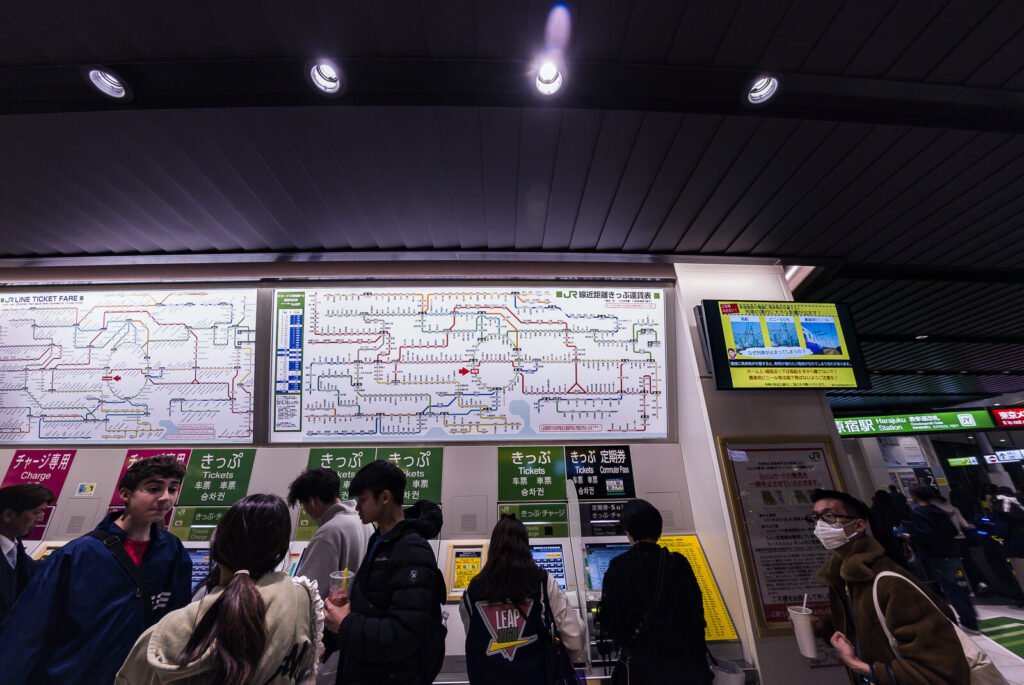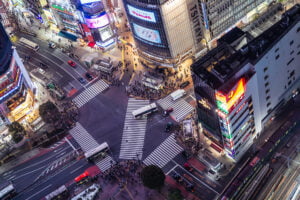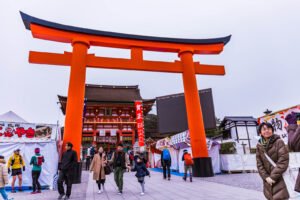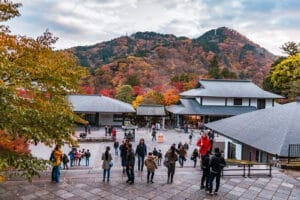Introduction
When it comes to exploring the vibrant city of Tokyo, the efficient and extensive Tokyo transportation system is your key to unlocking its wonders. From sleek bullet trains to intricate subway networks, Tokyo’s transportation infrastructure is a marvel that makes traversing the city a breeze. In this article, we’ll guide you through the ins and outs of Tokyo’s public transportation, ensuring you can navigate with confidence.

The Tokyo Metro: A Web of Convenience
Subway Lines and Color Codes
Tokyo’s subway system consists of various lines, each color-coded for ease of identification. From the iconic Ginza Line (orange) to the efficient Marunouchi Line (red), understanding the color codes simplifies your navigation.

Purchasing Tickets and IC Cards
For your convenience, ticket vending machines are available at all stations, complete with English menus to assist you in your purchase. These machines not only provide tickets with English information but also offer options to buy limited express tickets and reserve seats for a comfortable travel experience.
Traveling in Japan is made seamless with IC Cards, your go-to for a hassle-free journey. These Integrated Circuit Cards are rechargeable and widely accepted for public transport fares, as well as payments in shops, restaurants, and vending machines across Japan.
Nationwide Use
Ten types of local IC Cards, including Suica, Pasmo, and Icoca, are interchangeable and can be used nationwide. Suica and Pasmo are available in Tokyo, while Icoca is accessible in the Osaka and Kyoto regions.
Transportation Access
With an IC Card, you can navigate the extensive networks of trains, subways, and buses in major cities like Tokyo, Osaka, Kyoto, Nagoya, Fukuoka, and Sapporo.
Important Considerations
- Travel is restricted within IC card areas; both departure and destination stations must be within the zone.
- IC Cards are not valid for travel between disjointed IC card areas or on shinkansen trains without prior setup.
- For limited express trains requiring a supplement fee, the base fare can be paid with an IC Card, but a separate supplement ticket is necessary.
Purchasing and Charging
IC Cards can be bought at ticket machines and counters of railway companies, with a 500 yen refundable deposit and an initial charge, typically 1500 yen. Recharge your card at ticket machines, special recharging stations, or even at convenience store cashiers.
Refunds
To refund your deposit and unused credit (minus a handling fee), return the card to the issuing company’s counter. Note that cards like Suica must be returned in eastern Japan and are not refundable in Osaka.
Mobile Convenience
For iPhone 8 or later models, add your IC Card to ApplePay for ease of use. Android phones sold outside Japan may not support mobile IC card functions.
Special Tourist IC Cards
- Welcome Suica: No deposit required, valid for 4 weeks, with no balance refund.
- Kansai One Pass: Functions like a regular IC card with added discounts at tourist spots.
Shinkansen Usage
IC Cards can be registered online for shinkansen travel, with fares charged to a linked credit card, not the IC card’s balance. The “Touch de Go” system allows for non-reserved shinkansen seat payments directly from the card’s balance.
Embrace the convenience of IC Cards and enjoy the ease they bring to exploring Japan’s wonders!
Navigating Subway Stations
Navigating Tokyo transportation system is a breeze once you get the hang of it. Here’s a quick guide to help first-time visitors find their way:

Navigation Tips
- Follow bilingual signs to platforms and exits.
- Stand on the left side of escalators.
- Utilize apps for real-time navigation and exit information.
Exiting the Subway
- Choose the correct gate to avoid extra charges.
- Identify the right exit number for your destination with Google Maps.
Station Navigation
- Look for clear station markings above ground.
- Inside, blue signs lead to platforms; yellow signs point to exits.
Additional Tips
- Some gates are IC card-exclusive.
- Complete transfers within 30 minutes.
- Exiting and re-entering the same station will incur a charge.
With these tips, you’ll find that moving around Tokyo’s subway stations is straightforward. Keep your ticket or IC card until the end of your journey, and enjoy exploring the city! Remember, station attendants are always ready to assist if you need help.
The JR Lines: Seamless Connectivity
The Yamanote Line: Tokyo’s Circular Route
The Yamanote Line is a circular route connecting major districts like Shibuya, Shinjuku, and Akihabara. It’s a fantastic way to experience Tokyo’s diversity and efficiency in one loop.

The Yamanote Line is the lifeline of Tokyo, connecting the city’s heart with its vibrant limbs. Here’s a distilled guide for first-time visitors:
Yamanote Line at a Glance
- Opened in 1885, the Yamanote Line is an above-ground loop that circles central Tokyo.
- With 30 stations, it’s a gateway to key areas like Shinjuku, Shibuya, and Tokyo Station.
- It’s known for its frequent service, with trains every two to five minutes.
Why It’s Unique
- Unlike many urban railways, the Yamanote Line is entirely above ground, offering scenic views of Tokyo’s “missing middle” density.
- It forms a heart-shaped loop, connecting major north-south corridors and business districts.
Connectivity
- Most stations offer cross-platform transfers to other lines, making it a hub of connectivity.
- Only two stations don’t connect to other rail services, showcasing its integration into Tokyo’s transport network.
For Travelers
- The line is covered by the JR Pass, making it cost-effective for tourists.
- Key attractions like Akihabara, Harajuku, and the Imperial Palace are all easily accessible from the Yamanote Line.
Stations and Safety
- Stations feature platform gates for safety, allowing fast train entry and exit.
- Wayfinding is user-friendly, with tactile guides leading through stations and onto streets.
The Bigger Picture
- The Yamanote Line exemplifies the importance of a well-connected transit network.
- It’s not just a transport artery but a network enhancer, facilitating seamless transfers and boosting ridership across Tokyo.
For anyone visiting Tokyo, the Yamanote Line is more than just a train service; it’s a cultural experience and a testament to efficient urban mobility. Enjoy the ride!
Using the JR Pass for Tourists
If you plan to explore Tokyo and beyond, consider the JR Pass. This pass grants unlimited travel on JR trains, including some shinkansen (bullet trains), and can be a cost-effective choice.
For first-time visitors to Japan, the Japan Rail Pass (JR Pass) is a convenient and cost-effective way to travel. Here’s what you need to know:
JR Pass Overview
- The JR Pass allows unlimited travel on most JR trains, including all but the fastest Shinkansen bullet trains.
- Available for 7, 14, or 21 days, with prices starting from 50,000 Yen.
Who Should Get the JR Pass
- Ideal for travelers planning multiple long-distance trips across Japan.
- Offers flexibility and savings, especially for those traveling from north to south and back.
Purchasing and Activation
- Must be purchased before arriving in Japan.
- Activate the pass at any JR office, including airports like Narita or Haneda.
- Choose the activation date within 30 days after exchanging the voucher.
Using the JR Pass
- Covers basic fares; additional fees apply for premium services like sleeper trains.
- Reserve seats online or at JR ticket offices.
- Children aged 6–11 can use a child pass for half the adult fare.
Regional Passes
- Consider regional passes for localized travel, which can offer additional benefits and savings.
- Examples include the Tokyo Wide Pass, Hokkaido Rail Pass, and others tailored to specific regions.
Luggage Rules
- Follow the luggage size rules for Shinkansen trains to avoid fines.
- Oversized baggage area reservations are recommended for large items.
Tips
- Use navigation apps like Google Maps or Navitime for route planning.
- Combine different passes for further discounts if your travel plans are well-researched.
The JR Pass is a valuable tool for exploring Japan’s diverse regions and can significantly reduce travel costs. Make sure to assess your itinerary to determine if the JR Pass or regional passes best suit your travel needs. Enjoy your journey through Japan!
Exploring Beyond Tokyo with Shinkansen
Tokyo serves as a hub for Japan’s impressive shinkansen network. Within a few hours, you can venture to cities like Kyoto, Osaka, and Hiroshima for unforgettable day trips.

Embarking on a journey aboard Japan’s Shinkansen, or bullet trains, is an experience like no other. Here’s a concise guide for first-time visitors to navigate this high-speed marvel:
Shinkansen Overview
- Speed: Travels up to 320 km/h.
- Key Service: Nozomi, the fastest, takes you from Tokyo to Kyoto in just 2 hours and 15 minutes.
Tickets
- JR Pass: Offers unlimited travel; must be purchased before arriving in Japan.
- Single Journey Tickets: Can be bought at stations or online.
Classes of Service
- Unreserved Cars: First-come, first-served seating.
- Reserved Cars: Guaranteed seating; slightly more expensive.
- Green Class: Comparable to business class; offers more comfort.
- Gran Class: The luxurious option, akin to first class.
Purchasing Tickets
- In-Person: At JR ticket offices (Midori-no-Madoguchi) or ticket machines.
- Online: Through platforms like Klook or SmartEX, or directly from JR websites.
Luggage
- Allowance: Two pieces, up to 30 kg each.
- Oversized Luggage: Requires a reserved seat with a dedicated baggage area.
Onboard Etiquette
- Eating and Drinking: Allowed; ekiben (train bento boxes) are popular.
- Amenities: Outlets, free Wi-Fi, and tray tables are standard; Green cars have additional comforts.
Important Tips
- Seat Reservations: Can be changed at ticket offices or machines.
- Missed Trains: With reserved tickets, you can still ride unreserved on the same day.
- Hop-On Hop-Off: Not allowed with single-journey tickets; possible with a JR Pass.
Traveling by Shinkansen is not just about speed; it’s about experiencing Japanese efficiency and hospitality at its finest. Enjoy your ride!
Buses: Exploring the Streets Above Ground

Tokyo Bus Network and Routes
Welcome to Tokyo, a bustling metropolis where the local bus system offers a convenient way to explore the city. Here’s a complete guide to help you navigate the city buses with ease:
- Planning Your Route:
Use Google Maps to find the best bus route from your location to your destination. It will display nearby bus stops, schedules, and fare information, making your commute hassle-free. - At the Bus Stop:
Look for the bus number, timetable, and fare details displayed at the stop. This information is available for both working days and holidays. - Boarding the Bus:
Buses in Tokyo have two doors. Enter through the rear (2nd) door and exit from the front (1st) door. - Paying the Fare:
For a seamless experience, use an IC Card like Pasmo or Suica. Simply tap your card upon entry and again when exiting to pay your fare. If you don’t have an IC Card, take a ticket when you board and deposit it along with the fare in the coin box upon exiting. - Seating:
If seats are available, feel free to sit down after you board. Ensure the bus has started moving before settling in. - Riding During Peak Hours:
The buses can get crowded during peak hours. Standing is normal, so hold onto the handrails provided. - Priority Seating:
The front section of the bus has single seats designated as priority seating for the elderly, individuals with special needs, women with children, patients, and pregnant women. It’s customary to vacate these seats for priority passengers when needed. - Staying Informed:
Buses are equipped with an automatic announcement system that alerts passengers to upcoming stops. Pay attention to these announcements. - Signaling Your Stop:
When your stop is approaching, press the yellow bell located near each seat or standing rail to alert the driver. - Exiting the Bus:
Remain seated until the bus comes to a complete stop to ensure your safety. - Fare Information:
An electronic board inside the bus displays the fare amount you need to pay. - Departing the Bus:
Exit through the front door.
By following these simple steps, you’ll be able to ride the Tokyo buses like a local. Enjoy your journey through the city!
Bus Fares and Payment Methods
Bus fares are calculated based on distance. IC cards are widely accepted, and if you’re using cash, be sure to pay the exact fare in the coin box near the driver.
Apps for Bus Routes and Schedules
Apps like “Japan Transit Planner” and “NAVITIME for Japan Travel” help you navigate Tokyo’s bus routes, providing real-time schedules and optimal routes.
Navigating the Tokyo Metro and JR Together
Transferring Between Metro and JR Lines
At certain major stations, like Tokyo Station and Shinjuku Station, you can easily transfer between the subway and JR lines. These stations often have multiple lines converging, so follow signs diligently. Please be aware that transfers must be completed within 30 minutes, or you will require a new ticket.
Interchanging at Major Stations
Some stations, like Shibuya and Shinjuku, require longer walks for transfers due to the size and complexity of the stations. Allow ample time to switch lines.
Accessibility and Convenience
Elevators, Escalators, and Barrier-Free Travel
Many stations offer elevators and escalators for easy accessibility. Look for stations with an “S” symbol for accessibility information.
Station Facilities and Amenities
Tokyo’s major stations often have a wealth of facilities, including shopping malls, restaurants, and even entertainment complexes.
Tips for Stress-Free Travel
Avoiding Rush Hours
Rush hours (8-9 AM and 5-7 PM) can be incredibly crowded. If possible, plan your travel outside these times to ensure a more comfortable journey.
Planning Routes in Advance
Use apps like Google Maps or Japan’s official navigation apps to plan your routes in advance. These apps provide accurate information on schedules and platforms.
Embracing Japanese Etiquette
In Japan, etiquette is paramount, especially on public transportation. Here’s a guide to help you navigate the cultural nuances of train and bus travel in Tokyo:
- Be Prepared:
Have your tickets or IC cards ready and charged before approaching the ticket gates. This helps avoid delays and keeps the flow of passengers smooth. - Mindful Movement:
Avoid using your smartphone or other devices while walking around the station. This ensures you’re aware of your surroundings and prevents accidents. - Boarding Protocol:
Always wait for passengers to disembark before boarding the train. Rushing to get a seat is considered rude and can make you quite unpopular. - Phone Etiquette:
Refrain from talking on your phone. The Japanese value a quiet environment, so even a whispered conversation can be disruptive. - Keep It Down:
Speak softly if you need to converse, and ensure your music volume is low enough not to disturb others. - Eating and Drinking:
Avoid consuming smelly food or alcohol on the train. Non-aromatic snacks, water, or coffee are generally acceptable. - Personal Space:
Respect others’ space by not manspreading or falling asleep on fellow passengers. - Backpack Courtesy:
Wear your backpack on the front or hold it in your hand to avoid bumping into others.
By following these simple rules, you’ll contribute to the harmonious atmosphere that makes traveling in Japan a pleasant experience for everyone.
Conclusion
Navigating Tokyo transportation might seem overwhelming at first, but with a bit of preparation and the help of this guide, you’ll find it surprisingly straightforward. Tokyo’s efficient trains, buses, and stations make exploring this dynamic city a rewarding adventure. So, embark on your journey, explore with confidence, and immerse yourself in the heart of Tokyo’s urban tapestry.
FAQs
What is the best way to get around in Tokyo?
The subway is the best way to get around Tokyo. You can get from one part of the city to another as quickly as possible.
What is the main mode of transport in Tokyo?
The subway is the main mode of transport in Tokyo.
How do I pay for transport in Tokyo?
Cards like Pasmo and Suica are the best way to pay for transportation.
How do tourists travel in Tokyo?
Tokyo’s public transportation system is very punctual and efficient. Apart from trains and buses, you can also use taxis.
Which is better, Suica or Pasmo?
Both are almost the same. The only difference is the company that provides the card. Suica is provided by JR East and Pasmo is provided by Tokyo Metro. Both are interchangeable, which means you can ride JR trains with a Pasmo and private lines with a Suica.
Is there an Uber in Tokyo?
Uber in Japan has been around since 2018, but it’s available only in larger cities like Tokyo and Osaka.
Is Tokyo a walkable city?
According to Compare the Market, Tokyo is one of the most walkable cities in the world, and it is the number one walkable city in Asia.
Can foreigners use Suica?
Certainly! Foreigners can indeed use Suica cards in Japan. However, there are a few important details to consider:
Regular Suica Cards:
Foreign tourists can obtain regular Suica cards at Narita Airport and major JR East train stations.
These cards require a 500-yen deposit when purchased, which can be refunded upon returning the card.
Regular Suica cards do not have an expiration date and can be used indefinitely, as long as they are used at least once every ten years.
Welcome Suica (Special Version for Tourists):
Welcome Suica is a special IC card designed exclusively for visitors to Japan.
It features a red and white design, symbolizing the sun and cherry blossoms.
Unlike regular Suica cards, there is no initial deposit required for Welcome Suica.
However, it has a validity period of 28 days from the first swipe, after which it is automatically deactivated.
Although Welcome Suica is not refundable, it remains a convenient travel card for your stay in Japan.
Where to Buy:
Currently, foreign tourists have the option to purchase unregistered Suica cards (the green regular version) at JR East Japan Travel Service Centers in Tokyo, Shinagawa, Shibuya, Shinjuku, Ikebukuro, or Ueno stations. Keep in mind that the availability of regular Suica cards may be limited due to current shortages, so consider opting for Welcome Suica if you’re visiting for a short period.
Remember to choose the option that best suits your travel needs! 🚆🇯🇵
How to get around Tokyo as a tourist?
The best way to get around Tokyo is to use the Yamanote Line, which runs in a loop around Tokyo and covers major stations.
Can two people use the same Suica card?
Everyone needs to have their own Suica card especially if they are travelling in a group.
More from Airashi Japan
Navigating Tokyo Transportation efficiently
Tokyo Shibuya Crossing: The World’s Busiest Intersection
Japanese Temples: Senso-ji and Nakamise Shopping Street
Exploring Tokyo: Unveiling Top Attractions and Hidden Gems
Kichijoji: Unveiling the Charm of Tokyo’s Hidden Gem
Yanaka: Old-World Charm and Quaint Streets
The Mystical Allure of the Torii Gate: A Gateway to Japanese Culture
Meiji Shrine: Journeying Through Tokyos Meiji Shrine
Exploring the Heart of Tokyo: Shinjuku
Tokyo Tower: Panoramic City Views
Omoide Yokocho: Tokyo’s Nostalgic Alley of MemoriesAkihabara Electric Town : Tech and Anime Haven
Roppongi Tokyo: Fusion Hub of Culture and Nightlife
Harajuku Japan: A trendsetter’s Heaven






Pingback: Tokyo Travel : How to Experience the Best of the City in Just 24 Hours! - airashijapan.com
Pingback: Exploring Tokyo: Unveiling Top Attractions and Hidden Gems - airashijapan.com
Pingback: Tokyo budget hotels: Comfortable Stays That Won’t Break the Bank - airashijapan.com
Pingback: 20 Best Budget Hotels Tokyo: Affordable Stays in the Heart of Japan’s Capital - airashijapan.com
Pingback: Kichijoji: Unveiling the Charm of Tokyo’s Hidden Gem - airashijapan.com
Pingback: Tokyo Travel Tips : How to Experience the Best of the City in Just 24 Hours! - airashijapan.com
Thank you very much for this information. I’m visiting your country from the UK in 2024 and need to make my time there effective.
Kind regards
Christina
Thanks Christina!
If you need any information regarding travelling in Japan, you can ask me.
Pingback: The Mystical Allure of the Torii Gate: A Gateway to Japanese Culture - airashijapan.com
Pingback: Exploring the Heart of Tokyo: Shinjuku - airashijapan.com
Pingback: Omoide Yokocho: Tokyo’s Nostalgic Alley of Memories - airashijapan.com
Pingback: Japanese Temples: Senso-ji and Nakamise Shopping Street - airashijapan.com
Pingback: Akihabara Electric Town : Tech and Anime Haven - airashijapan.com
Pingback: Roppongi Tokyo: Fusion Hub of Culture and Nightlife - airashijapan.com
Pingback: Harajuku Japan: A Trendsetter’s Haven - airashijapan.com
Pingback: Best Places to See Autumn Foliage in Tokyo - airashijapan.com
Pingback: Recommended Reading for Your Journey to Japan - airashijapan.com
Pingback: Exploring Kagurazaka: A Tapestry of Tradition and Modernity in Tokyo - airashijapan.com
Pingback: Best Japan Travel Apps - airashijapan.com
Pingback: Spring in Tokyo: Sakura Dreams at Shinjuku Gyoen - airashijapan.com
Pingback: Harajuku St: Where Tokyo Street Photography Comes Alive - airashijapan.com
Pingback: Yanaka: Old-World Charm and Quaint Streets - airashijapan.com
Pingback: Nikko Autumn: A Symphony of Colors - airashijapan.com